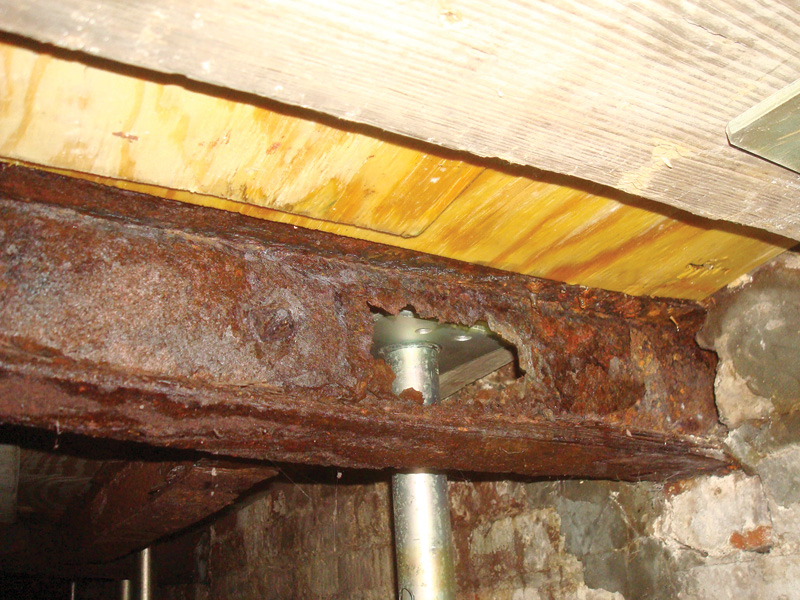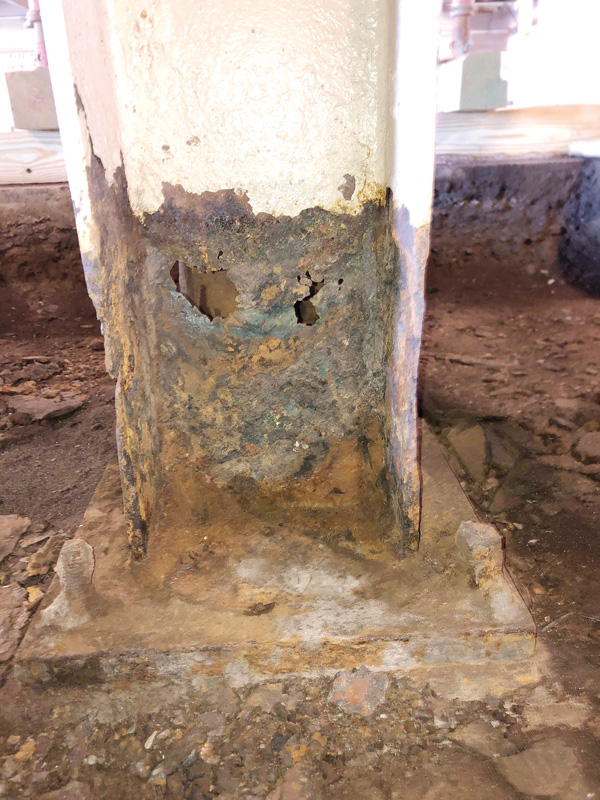Structural steel corrosion: Evaluation and repair

Corroded structural steel framing is often encountered in existing buildings. This condition commonly occurs at locations where steel elements have been repeatedly exposed to moisture over time. Given the potential consequences associated with such conditions, it is necessary to understand the appropriate steps for the identification, assessment, and remediation of elements exhibiting various degrees of deterioration.
While most structural steel that is enclosed within a building is generally protected from sources of moisture that are likely to cause corrosion, some common conditions that frequently lead to problems include leakage through building enclosure systems, plumbing leaks, exposure to caustic chemicals, or undesirable construction practices such as placing steel elements in direct contact with concrete or masonry with exterior exposure. Steel framing in parking garages and sidewalk vaults is particularly susceptible to corrosion due to leakage through overhead concrete slabs and exposure to deicing salts used during winter. Deferred maintenance of protective coating systems for the steel can also accelerate corrosion.

Evaluation of corroded structural steel elements requires the expertise of a structural engineer familiar with assessing and repairing such conditions. Once identified, it is important to determine how much of the original member cross-section has been lost to corrosion and compare its remaining strength to the required loading demands (section loss of 10 to 15 percent generally raises structural concerns). Corrosion scale can expand to 10 times the volume of the original material and this can be deceiving as to the degree of section loss that has actually occurred. Since corrosion can result in increased thickness of the affected element, removal of the build-up of corrosion product is required to facilitate measuring the remaining steel thickness. Measurements can be made using traditional measuring tools when the element being measured has an exposed edge; however, where this cannot be accomplished due to access limitations, measurements can be taken utilizing non-destructive testing instruments such as an ultrasonic thickness gauge (an electronic device capable of measuring the thickness of a material from contact with an exposed surface).
If the section loss due to corrosion is determined to be structurally significant, reinforcement or replacement of a portion of or the entire member will typically be required. Reinforcement of structural steel members is commonly performed by welding or bolting additional plates or structural shapes to the deteriorated member. Design and implementation of the repairs require careful planning and sequencing, often utilizing temporary shoring to support the structure while repairs are made. Guidance for repair and strengthening structural steel members can be found in the International Existing Building Code and the American Institute of Steel Construction (AISC), Design Guide 15 Rehabilitation and Retrofit Guide.
Author
Alexandar J. Mlynarczyk, PE, is an associate principal with the Princeton, New Jersey, office of Wiss, Janney, Elstner (WJE) Associates, Inc., specializing in investigation and repair of building structures. He can be reached at amlynarczyk@wje.com.
The opinions expressed in Failures are based on the authors’ experiences and do not necessarily reflect that of The Construction Specifier or CSI.



